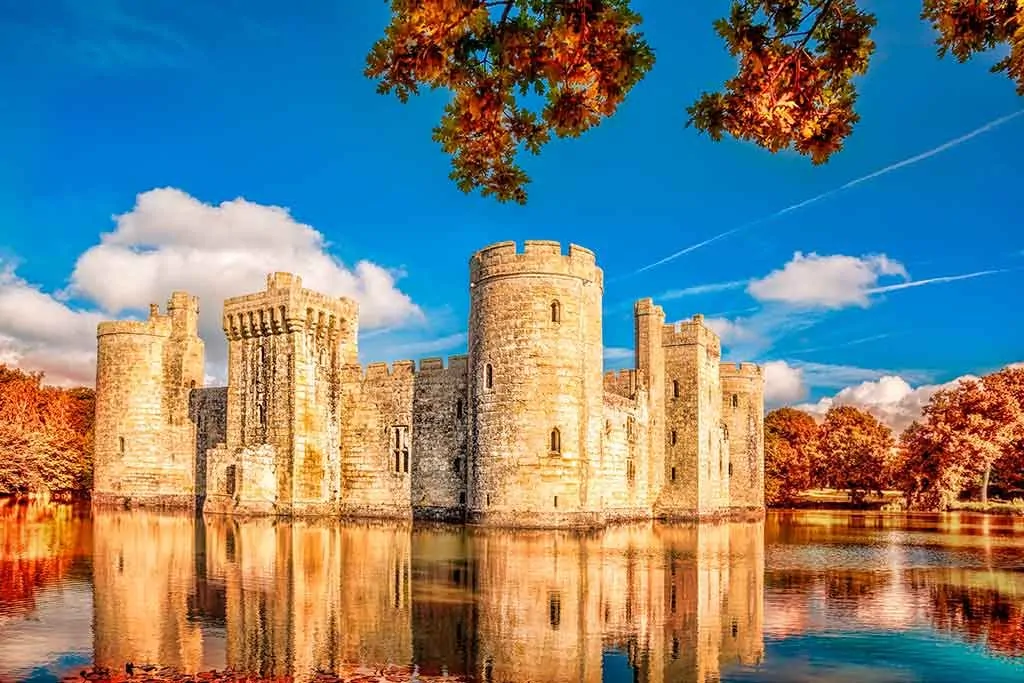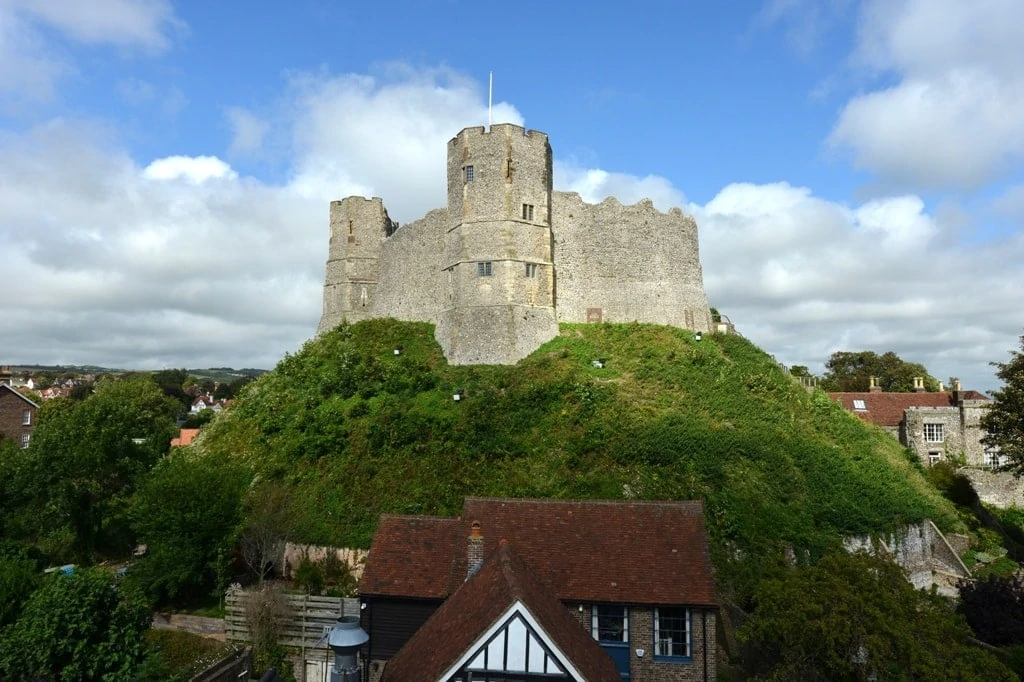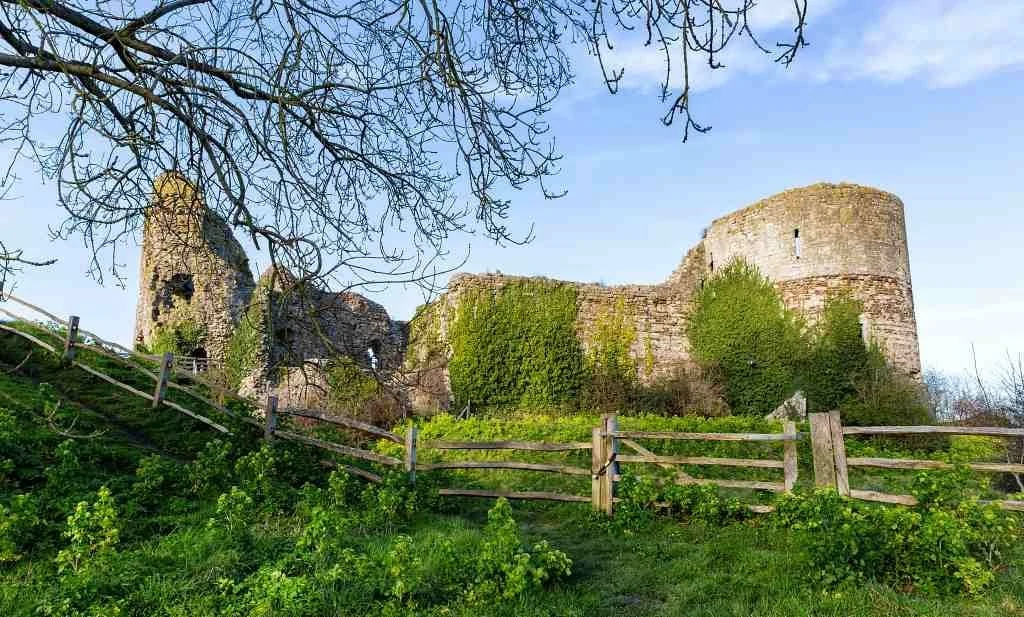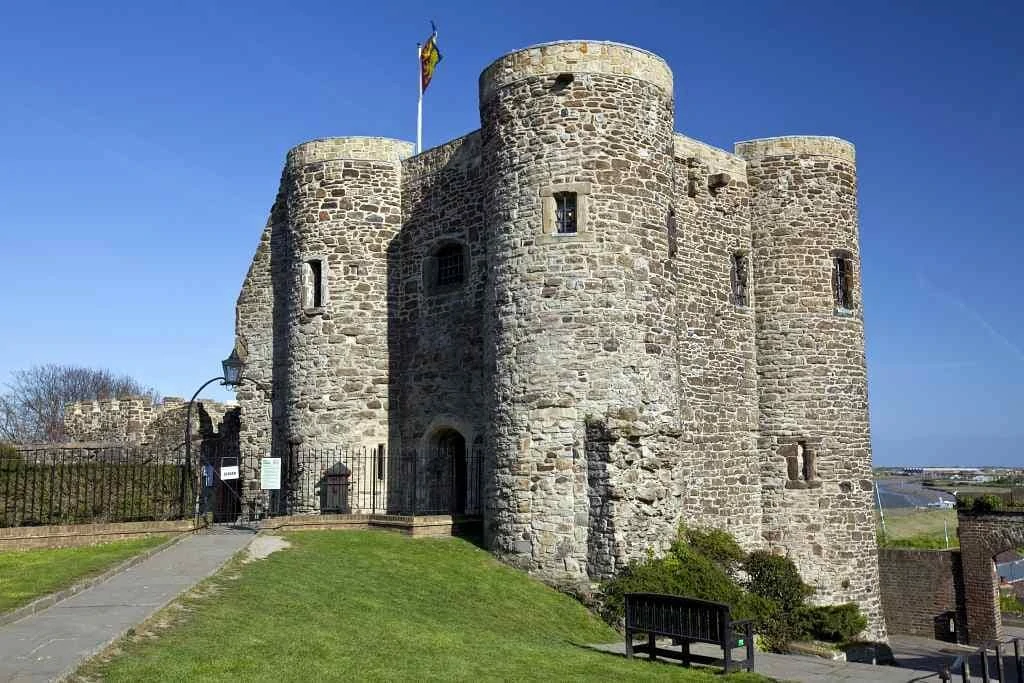This historic part of England is where William the Conqueror first landed in the United Kingdom in 1066. It’s where you’ll find some of the oldest castles in the UK. Not only that, but it’s also home to some outstanding natural beauty, such as the Seven Sisters Chalk Cliffs and Beachy Head, as well as the UK’s newest national park – The South Downs.
And we can’t forget the vibrant and exciting cities such as Brighton, Hastings, and Eastbourne, from which you can take a drive through the rolling countryside to discover medieval villages and traditional country pubs.
Another great thing about East Sussex is that you don’t even need to stay in the county to get to know it. Some of these castles in East Sussex are a fun and easy day trip from London.

7 Castles To Visit In East Sussex
1. Bodiam Castle

Set against the backdrop of green fields, Bodiam Castle is a picturesque medieval castle in the centre of a moat built in the 14th century.
The original owner, Sir Edward Dalyngrigge, was encouraged to fortify his existing home by the Plantagenet King Richard II, but Dalyngrigge decided to build a full-blown castle anyway.
Although the castle is largely ruined, you can still see the opulence of the manor house, which had 33 fireplaces. Bodiam Castle became a popular tourist destination in the Victorian era and has remained so today.
Where: Robertsbridge
When: 14th century
Style: Medieval Moated Castle
Open for visit: Yes, check here for more information.
2. Camber Castle

It’s a bit tricky to get to Camber Castle, but it’s well worth the effort of the mile-long walk from the town of Rye. The castle was constructed by Henry VIII and was built to overlook the sea and protect Rye and Winchelsea from invading French forces.
The ruins of the castle look like a flower from above, but it is actually a central keep surrounded by four circular bastions. You cannot enter the castle without being on a guided tour, but you can enjoy a picnic or a walk nearby.
Where: Rye
When: 16th century
Style: Device Fort
Open for Visit: Yes, for more information check here.
3. Hastings Castle

One of the most famous battle sites in the country, the ruins of Hastings Castle overlook the city from West Hill above the city. The construction of the castle is depicted in the Bayeux Tapestry. It was one of the first castles ordered to be built by William the Conqueror – along with Pevensey and Dover castle.
The castle lay ruined from 1399 but was restored and revived during the Victorian Era when Hastings became a popular holiday destination. It even had a role to play in World War II. As the city was heavily bombed, an anti-aircraft gun was installed on the castle’s east wall for protection against enemy planes.
Where: Hastings
When: 12th century
Style: Keep and Bailey castle
Open for visit: Yes, check here for more information.
4. Herstmonceux Castle

Said to be one of the oldest significant brick buildings in England, the imposing Herstmonceux castle has been standing since 1441. The moated castle sits among 550 acres of woodland and gardens, which you can visit freely in the summer months.
You can arrange a visit to the castle by appointment, but it is not freely open to the public as it is an international study centre for Queen’s University.
Where: Hailsham
When: 15th century
Style: Tudor
Open for visit: Yes, check here for more information.
5. Lewes Castle

Built shortly after the Norman invasion, work on Lewes castle started in the year after William the Conqueror arrived in Britain. In 1100, it was rebuilt in stone, and a second motte was added to support the keep.
The castle was attacked in the peasants’ revolt in the 14th century, and rioters stole wine from the cellars. After that, it was used as a prison. Originally called Bray Castle, the castle was designated a UNESCO World Heritage site in 1915 and looks out over the River Ouse and the South Downs.
Where: Lewes
When: 11th century
Style: Norman
Open for visit: Yes. Check here for more information.
6. Pevensey Castle

Pevensey was the landing place for William the Conqueror’s Army in 1066; however, this castle has another six centuries of history before that. It was one of the strongest ‘Saxon Shore’ forts built by the Romans, and some of those walls still stand.
William the Conqueror added to the castle, and it is one of the most impressive Norman castles in the UK. It also had a role to play in World War Two, which you can learn about at the on-site museum.
Where: Pevensey
When: 11th century
Style: Norman
Open for visit: Yes, check here for more information.
7. Rye Castle (Ypres Tower)

Rye Castle and the Ypres Tower were built to defend the south coast of England from invading French armies. During its lifetime, the castle has been a fort, prison, court hall, and now a museum.
The Ypres Tower is the second oldest building open to the public in the town of Rye. There is a small museum in the town dedicated to the castle too. Rye Castle and the Ypres Tower are just a 36-minute walk from Camber Castle, which we mentioned earlier.
Where: Rye
When: 13th century
Style: Medieval
Open for Visit: Yes. For more information check here.
